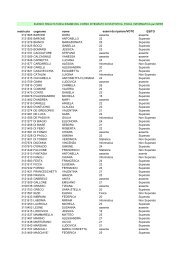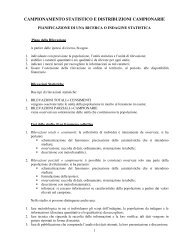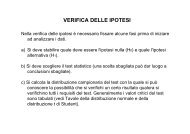Intervalli di confidenza - Biostatistica.unich.it
Intervalli di confidenza - Biostatistica.unich.it
Intervalli di confidenza - Biostatistica.unich.it
You also want an ePaper? Increase the reach of your titles
YUMPU automatically turns print PDFs into web optimized ePapers that Google loves.
che ha valor me<strong>di</strong>o µ e deviazione standard σ n = 1 3 . Estratto un campione casuale, si ipotizzi <strong>di</strong> aver<br />
ottenuto un valore x = 13.<br />
8 per la me<strong>di</strong>a campionaria.<br />
Come si usa questa informazione? Una variabile aleatoria X <strong>di</strong>stribu<strong>it</strong>a secondo la normale ha una probabil<strong>it</strong>à<br />
nota 1 − α <strong>di</strong> trovarsi in un intervallo centrato attorno al suo valor me<strong>di</strong>o e <strong>di</strong> ampiezza data pari ad a:<br />
Risolvendo rispetto a µ , si può anche scrivere:<br />
Prob( µ − a < X < µ + a)<br />
= 1−<br />
α .<br />
Prob( X − a < µ < X + a)<br />
= 1−<br />
α<br />
(*)<br />
che esprime il fatto che l’intervallo casuale ( X − a,<br />
X + a)<br />
contiene al suo interno la me<strong>di</strong>a µ con probabil<strong>it</strong>à<br />
pari a 1 − α . Si ottiene, in tal modo, un intervallo <strong>di</strong> fiducia per la me<strong>di</strong>a µ .<br />
L’approccio classico al problema è dunque il seguente: fissato un valore <strong>di</strong> probabil<strong>it</strong>à, ad esempio<br />
1 − α =0.95, si determina il valore a = a0.95 in modo che sia sod<strong>di</strong>sfatta la (*). Così facendo possiamo<br />
affermare che il “vero” me<strong>di</strong>o µ si trova, con probabil<strong>it</strong>à 1 − α = .95, nell’intervallo X − a , X + a ) .<br />
2<br />
( 0 . 95<br />
0.<br />
95<br />
Una volta effettuato il campionamento e calcolato x = 13.<br />
8 , l’intervallo <strong>di</strong> <strong>confidenza</strong> associato a tale<br />
campione è 13.<br />
8 − a , 13.<br />
8 + a ) : ma non è corretto <strong>di</strong>re che la probabil<strong>it</strong>à che µ cada in tale intervallo è<br />
( 0 . 95<br />
0.<br />
95<br />
0.95. In realtà, visto che la probabil<strong>it</strong>à che la me<strong>di</strong>a appartenga a X − a , X + a ) è 0.95, si ha fiducia<br />
( 0 . 95<br />
0.<br />
95<br />
che l’intervallo ottenuto della me<strong>di</strong>a campionaria x = 13.<br />
8 contenga il valore vero e incogn<strong>it</strong>o della me<strong>di</strong>a µ .<br />
In termini operativi ciò significa che estraendo ipoteticamente 100 campioni della stessa numeros<strong>it</strong>à n,<br />
ci si aspetta che per 95 <strong>di</strong> essi la me<strong>di</strong>a µ appartenga all’intervallo ( x − a 0 . 95,<br />
x + a 0.<br />
95 ) della me<strong>di</strong>a x<br />
ottenuta in ciascun campione. Il grado <strong>di</strong> fiducia che si attribuisce alla stima è espresso dal livello <strong>di</strong><br />
probabil<strong>it</strong>à 1 − α , detto livello <strong>di</strong> fiducia.<br />
Resta da calcolare il valore <strong>di</strong> a0.95. Per fare questo basta ricordare il proce<strong>di</strong>mento <strong>di</strong><br />
Z = ( X − µ ) σ n si <strong>di</strong>stribuisce secondo la<br />
standar<strong>di</strong>zzazione <strong>di</strong> una variabile normale. La variabile ( )<br />
normale standard e la <strong>di</strong>suguaglianza X − a 0.<br />
95 < µ < X + a 0.<br />
95<br />
è equivalente alla<br />
− a 0 . 95 n σ < z < + a 0.<br />
95 n σ . Quin<strong>di</strong> si ha: a 0.<br />
95 = z c σ n , essendo zc il valore della variabile normale<br />
standard per cui Prob(-zc < z < zc) = 0.95. In realtà il valore zc (detto valore cr<strong>it</strong>ico) è tale che le due code<br />
rispettivamente a destra <strong>di</strong> zc e a sinistra <strong>di</strong> –zc abbiamo entrambe probabil<strong>it</strong>à uguale a ( 1−<br />
0.<br />
95)<br />
/ 2 = 0.<br />
025 ,<br />
ossia del 2.5%. Utilizzando la tabella della <strong>di</strong>stribuzione normale standard (Appen<strong>di</strong>ce Dispensa Distribuzione<br />
Normale) si ottiene che zc ≈ 1.96. Si può allora concludere con i dati del nostro esempio che: il vero valore<br />
del valor me<strong>di</strong>o µ si trova, con un livello <strong>di</strong> <strong>confidenza</strong> del 95%, nell’intervallo (13.8 - 1.96/ 9 , 13.8 +<br />
1.96/ 9 ) ≈(13.15, 14.45).<br />
Si osservi che per ogni estrazione <strong>di</strong> campione si ottiene un intervallo <strong>di</strong> confìdenza <strong>di</strong>verso. Ognuno<br />
<strong>di</strong> essi è un intervallo <strong>di</strong> <strong>confidenza</strong> “lec<strong>it</strong>o”.<br />
C’è un modo un pò <strong>di</strong>verso <strong>di</strong> interpretare lo stesso calcolo. Secondo questo punto <strong>di</strong> vista <strong>di</strong>remo che<br />
il valor me<strong>di</strong>o µ appartiene all’intervallo appena costru<strong>it</strong>o al livello <strong>di</strong> errore del 5%.. Questo signifìca che<br />
se si assume che il valor me<strong>di</strong>o appartiene all’intervallo si può commettere un errore (cioè µ può anche non<br />
appartenere all’intervallo), ma la probabil<strong>it</strong>à <strong>di</strong> sbagliare è solo del 5%.<br />
Esempio1. Si vuole stimare il “vero” valore me<strong>di</strong>o µ dell’uricemia in una popolazione maschile; è<br />
noto che in tale popolazione la <strong>di</strong>spersione dell’uricemia è σ = 1.1 mg/dl. Si assume un livello <strong>di</strong> <strong>confidenza</strong><br />
del 95%.





